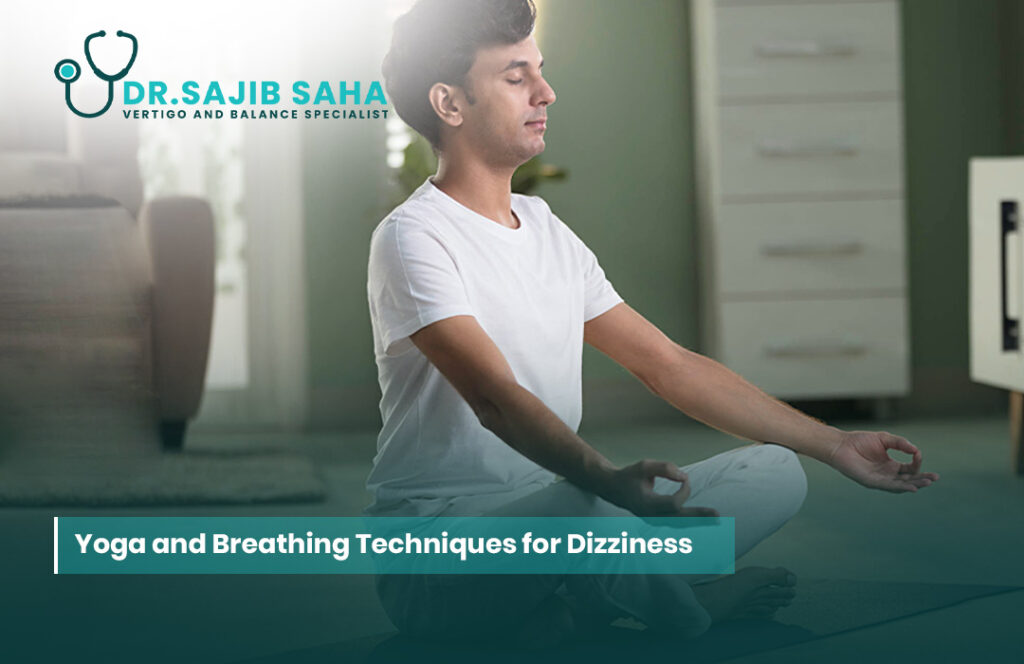Dizziness can make everyday activities challenging, leaving you feeling off balance and uncomfortable. While medical treatment is often necessary for underlying conditions, many people also find relief through natural practices. Yoga and breathing techniques for dizziness are simple, safe, and effective ways to improve balance, reduce stress, and enhance blood circulation.
In this post, we’ll share step-by-step yoga poses, breathing exercises, and relaxation techniques you can try at home.
Why Yoga and Breathing Help with Dizziness
Yoga and pranayama (breathing practices) improve oxygen supply to the brain, enhance balance, and calm the nervous system. These methods:
- Promote better blood circulation.
- Reduce anxiety and stress that may worsen dizziness.
- Strengthen inner ear and body balance.
- Offer a natural way to manage dizziness at home.
1. Yoga Poses for Dizziness Relief
a) Tadasana (Mountain Pose)
How to do it:
- Stand tall with feet together.
- Keep your arms by your sides.
- Inhale deeply, raise your arms overhead, and stretch upward.
- Hold for 20–30 seconds while breathing normally.
- Slowly release.
Benefits: Improves posture, enhances stability, and helps with balance issues.
b) Balasana (Child’s Pose)
How to do it:
- Kneel on the floor, sitting back on your heels.
- Stretch your arms forward and rest your forehead on the mat.
- Take slow, deep breaths.
- Hold for 1–2 minutes.
Benefits: Relieves stress, calms the mind, and improves blood flow to the brain.
c) Viparita Karani (Legs-Up-the-Wall Pose)
How to do it:
- Sit close to a wall and lie down on your back.
- Lift your legs and rest them against the wall.
- Keep your arms relaxed at your sides.
- Breathe slowly for 5–10 minutes.
Benefits: Improves blood circulation, reduces lightheadedness, and promotes relaxation.
2. Breathing Techniques (Pranayama) for Dizziness
a) Anulom Vilom (Alternate Nostril Breathing)
Steps:
- Sit in a comfortable position.
- Close your right nostril with your thumb, inhale through the left nostril.
- Close the left nostril, exhale through the right.
- Repeat for 5–7 minutes.
Benefits: Balances oxygen flow, reduces stress, and improves focus.
b) Bhramari (Bee Breathing)
Steps:
- Sit comfortably, close your eyes.
- Place your fingers gently on your ears.
- Inhale deeply, then exhale while making a humming sound like a bee.
- Continue for five rounds.
Benefits: Calms the nervous system, reduces anxiety-related dizziness.
c) Deep Belly Breathing
Steps:
- Sit or lie down comfortably.
- Place one hand on your belly and the other on your chest.
- Inhale deeply through your nose, allowing your belly to rise.
- Exhale slowly through your mouth.
- Repeat for 5 minutes.
Benefits: Enhances oxygen supply to the brain, reduces lightheadedness.
3. Relaxation and Lifestyle Tips
- Stay hydrated throughout the day.
- Avoid sudden head movements.
- Practice yoga and breathing daily for long-term results.
- Get enough rest and manage stress.
When to See a Doctor
While yoga and breathing techniques can help manage dizziness naturally, persistent or severe dizziness may indicate an underlying condition. Consult Dr. Sajib Saha, an experienced ENT and vertigo specialist, for proper diagnosis and treatment.
Conclusion
Practicing yoga and breathing techniques for dizziness relief can make a significant difference in your daily life. Simple poses like Tadasana, Child’s Pose, and breathing practices such as Anulom Vilom or Bhramari can naturally improve balance and calm your mind. Combined with a healthy lifestyle, these techniques offer a safe, home-based approach to managing dizziness.
Start small, practice consistently, and consult a specialist if symptoms persist.
If you experience frequent dizziness, don’t ignore it. Book an appointment with Dr. Sajib Saha today for expert ENT and vertigo treatment.
